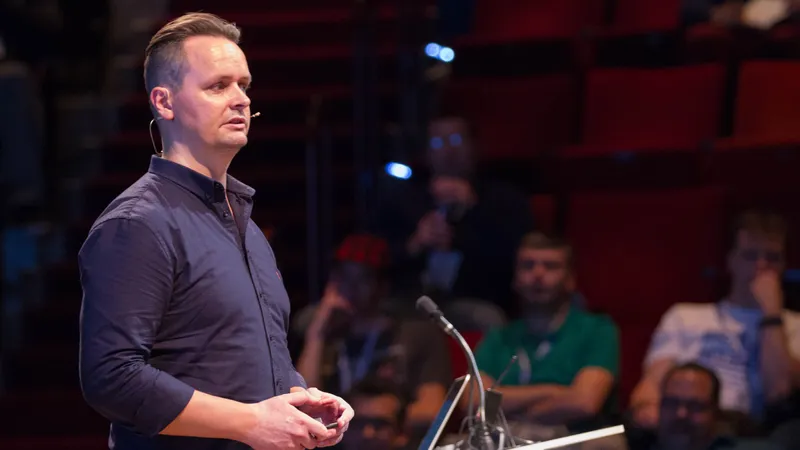Watch this JNUC session in its entirety.
Known for its superior ability to infuse learning and timeless fun into the ultimate toy for children and adults alike, LEGO® stepped beyond their manufacturing expertise to address their employees’ needs. They built Mac at LEGO.
“LEGO is, at its core, an old-school manufacturing company. LEGO is not a service provider,” LEGO Infrastructure Engineer Michael Loft Mikkelsen said. “Corporate IT at LEGO is a service provider, and we have to do that with the same attention to quality, detail and ease of use for our customers as the product we produce.”
IT at LEGO covers a broad pallet, including Mac, PC and Linux, though they only allow iOS devices. The department’s basic goal is to empower LEGO employees to be as happy and productive as possible when they come to work and play in an inspiring and empowering environment.
As part of the Mac team, Loft Mikkelsen began the process of choosing a management platform two years ago. At that time, LEGO employed more than 17,000 people across the globe, so they needed an IT infrastructure that was agile, scalable and robust enough to keep up with their development and growth.
LEGO currently has approximately 700 Macs, with the biggest concentration in Denmark. The rest are spread out across the globe. The majority of employees who use a Mac are designers and developers. “The goal of the Mac at LEGO project is to enable these colleagues to be as productive and inspired as possible,” Loft Mikkelsen said. “And we do that by providing them with the platform that fits them and their way of working – not a platform where we decide how they should work.”
Of course there’s a process before any employee receives their Mac. Prior to distribution, each Mac is integrated into the LEGO IT backend, where they mind it to AD. Every Mac receives a VPN, and automatic setup is scripted. Each Mac receives an office toolset and creative or developer tools, as needed.
But this wasn’t always the case. Previously, LEGO’s Mac infrastructure included one main management server in Denmark, with booster servers in four other countries. They didn’t have MDM capabilities. The supporters used ARD to support Windows, phones, mobile devices, AD, mail and Mac.
“When a new Mac was ordered, it had to be in the hands of a supporter to get through a manual reimage,” Loft Mikkelsen said. “We had single job scripts and manually deployed profiles. It’s enough to get anyone exhausted.” Simply stated - it wasn’t a workflow aimed at the IT Apple experience in the 21st Century.
An increasing amount of employees wanted Mac, but they were met with resistance from the company’s established IT organization. “We were pushing against ‘the old way’ mindset where everything is locked down,” Loft Mikkelsen explained. “The Mac is always being compared to the PC. It’s not enough to prove it’s just as capable in enterprise capabilities as the PC.”
And when employees had issues with their Macs, they avoided calling the Service Desk. They did any workaround possible to avoid the interaction. As the license count grew, so did the number of incidents being reported. It was essential to re-evalutate how IT operated. They needed a true enterprise solution.
“The growing Mac population also meant, that from the business side, demands were coming in to be able to, at a minimum, be able to use the same resources as the PC community,” Loft Mikkelsen explained.
So they identified three options:
- They could live with what they had.
- They could find a solution that piggy backed on their existing PC infrastructure.
- They could implement an Apple device management platform.
After narrowing their options, they decided to have a proof of concept with numbers 2 and 3. They identified their requirements and created 13 categories. After running two fully functional test environments, they voted. Jamf’s Casper Suite demonstrated to have the most capabilities for what they needed at LEGO.
“We’d made our choice. Now we had to draw the lines in the sand,” Loft Mikkelsen explained. “What were we going to do in the project? And even more importantly, what weren’t we going to do?”
They decided on a rollout that included three phases. It was ambitious, but doable. The process had ups and downs along the way, but is currently working on a happy ending. LEGO is currently on track and entering the last sprint of the rollout, finishing up enrollment in the U.S. and Asia. Wrapping it up, Loft Mikkelsen had lots of take-ways, with one a sure standout.
He said, “When you are considering solutions, it might very well be that a sales rep promises gold and green meadows. They might say it will fit perfectly. They might say you almost don’t even have to do anything. They might say, ‘It’s just a management layer.’ Alluring, right? Remember to be objective. Take ownership, test and verify, make your own decision. Nothing will ever just fit perfectly.”
by Category:
Have market trends, Apple updates and Jamf news delivered directly to your inbox.
To learn more about how we collect, use, disclose, transfer, and store your information, please visit our Privacy Policy.

